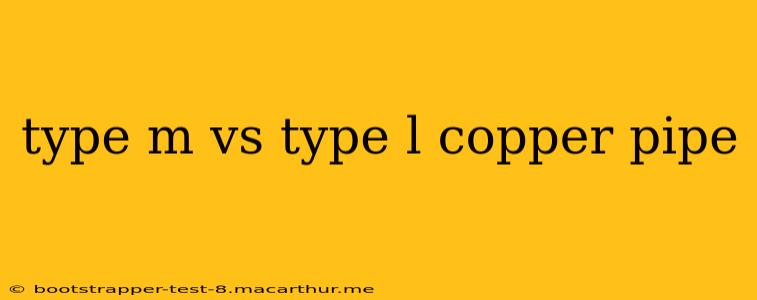Choosing the right copper pipe for your plumbing project is crucial for ensuring longevity, safety, and efficiency. Two common types, Type M and Type L, often leave homeowners and contractors wondering which is best. This comprehensive guide breaks down the key differences between Type M and Type L copper pipe, helping you make an informed decision.
What are Type M and Type L Copper Pipes?
Both Type M and Type L copper pipes are used extensively in residential and commercial plumbing systems. They are known for their durability, resistance to corrosion, and ability to withstand high water pressure. However, they differ significantly in their wall thickness. This difference directly impacts their strength, flexibility, and ultimately, their suitability for various applications.
Type L copper pipe has the thickest walls of the common copper pipe types. This makes it the strongest and most durable, able to withstand higher water pressures and more significant stresses.
Type M copper pipe has thinner walls than Type L, making it lighter and easier to work with. While still durable, it's not as robust as Type L and is generally less expensive.
What is the difference in wall thickness between Type M and Type L copper pipe?
The difference in wall thickness is the primary distinction between Type M and Type L copper pipes. Type L pipe has significantly thicker walls than Type M. This translates to increased strength and resistance to pressure but comes at a higher cost and may be less manageable for some installations. Specific dimensions vary depending on the pipe's diameter, but the relative difference in wall thickness remains consistent.
Which type of copper pipe is stronger, Type M or Type L?
Type L copper pipe is definitively stronger than Type M. Its thicker walls provide superior resistance to pressure, making it ideal for high-pressure applications or situations where extra durability is needed.
Which copper pipe is more expensive, Type M or Type L?
Type L copper pipe is typically more expensive than Type M. The increased material used in manufacturing contributes to its higher cost. This is a significant factor to consider when budgeting for a plumbing project.
Where is Type M copper pipe used?
Type M copper pipe is commonly used in applications where its strength is sufficient and cost-effectiveness is a priority. It is often a suitable choice for:
- Residential plumbing systems: In many residential settings, the water pressure is not high enough to necessitate the extra strength of Type L.
- Low-pressure applications: Type M performs well where the pressure demands are less intense.
- Applications where ease of installation is desired: The lighter weight of Type M makes it easier to handle and install.
Where is Type L copper pipe used?
Type L copper pipe is preferred where maximum strength and durability are paramount. This makes it ideal for:
- High-pressure applications: Its robust construction withstands higher water pressures without risk of failure.
- Commercial plumbing systems: Commercial buildings often require pipes capable of handling greater pressure and volume.
- Underground installations: The added strength protects against potential damage from ground movement or external forces.
- Areas prone to freezing: While not inherently more resistant to freezing, the greater wall thickness provides better protection if a freeze does occur.
Can I use Type M instead of Type L copper pipe?
Whether you can substitute Type M for Type L depends entirely on the specific application and local plumbing codes. In high-pressure situations, using Type M instead of Type L is strongly discouraged and might even be against building codes. Always check local regulations and consult with a qualified plumber to ensure the correct pipe type is used for your project. Compromising on strength could lead to pipe failure, leaks, and significant damage.
What are the pros and cons of each type of copper pipe?
Type L Copper Pipe:
Pros:
- High strength and durability
- Suitable for high-pressure applications
- Superior resistance to bursting
Cons:
- More expensive
- Heavier and less flexible
Type M Copper Pipe:
Pros:
- More cost-effective
- Lighter and easier to work with
- Sufficient for many residential applications
Cons:
- Less durable than Type L
- Not suitable for high-pressure applications
By carefully considering the application, budget, and local regulations, you can choose the appropriate copper pipe type for your project, ensuring a safe, efficient, and long-lasting plumbing system. Consulting a qualified plumber is always recommended to ensure compliance with all building codes and best practices.
